Sharpening a chainsaw with an angle grinder
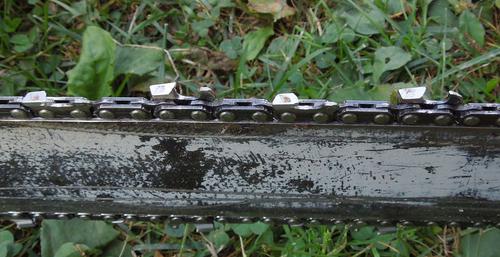 Chainsaws need sharpening from time to time, especially if you are cutting up
dirty logs or near the ground. The worst is if the teeth are dull towards
just one side. This causes the chain to deflect sideways, which results
in a cut that tries to follow a curve. That in turn can cause
the bar to get stuck in the kerf.
Chainsaws need sharpening from time to time, especially if you are cutting up
dirty logs or near the ground. The worst is if the teeth are dull towards
just one side. This causes the chain to deflect sideways, which results
in a cut that tries to follow a curve. That in turn can cause
the bar to get stuck in the kerf.
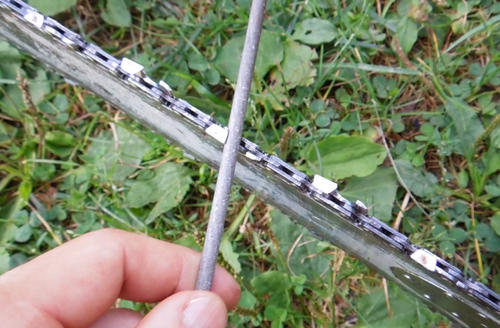 The conventional way to sharpen the chainsaw is with a chainsaw file.
There are all kinds of fancy jigs to help guide the file, but everyone
I know just clamps the chainsaw's bar in a vise and files it freehand.
The conventional way to sharpen the chainsaw is with a chainsaw file.
There are all kinds of fancy jigs to help guide the file, but everyone
I know just clamps the chainsaw's bar in a vise and files it freehand.
When cutting down some trees at my parents, the teeth were quite chipped towards one side, and about a millimeter of metal needed to be taken off to fix that. This is tedious with a file, but worse, all the files were full!
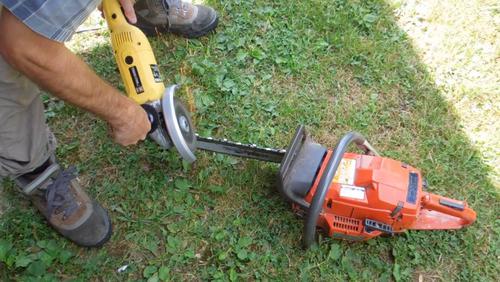 I had my angle grinder with me, so I figured, nothing to lose, and tried that!
I had my angle grinder with me, so I figured, nothing to lose, and tried that!
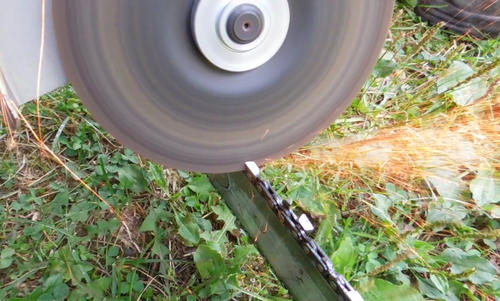 Worked like a charm. The trick is to angle the grinder blade back a bit, and
to alternate to one side or the other to follow the alternating skew angle
of the teeth.
Worked like a charm. The trick is to angle the grinder blade back a bit, and
to alternate to one side or the other to follow the alternating skew angle
of the teeth.
I had to be careful not to cut into the links themselves. The bigger risk is damaging the chainsaw bar, but I'd have to pretty much cut the chain apart before I'd damage the bar.
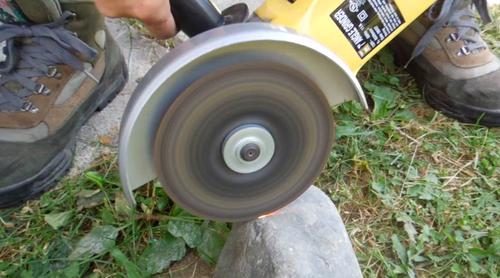 I just used a thin metal cutting disk. Sometimes
the edge of these needs a bit of dressing. A rock works well for that.
Solid rock is much harder than concrete, and the metal cutting
disk was no match for it.
I just used a thin metal cutting disk. Sometimes
the edge of these needs a bit of dressing. A rock works well for that.
Solid rock is much harder than concrete, and the metal cutting
disk was no match for it.
Cutting down a big tree
 The reason I had to sharpen the chainsaw was because a big tree needed cutting down.
Except for a little bit of green at the top, that tree was nearly dead.
It's best to cut down a tree while it's still physically sound.
Rotten trees can be unpredictable and dangerous to cut down.
The reason I had to sharpen the chainsaw was because a big tree needed cutting down.
Except for a little bit of green at the top, that tree was nearly dead.
It's best to cut down a tree while it's still physically sound.
Rotten trees can be unpredictable and dangerous to cut down.
This one was over 50 cm in diameter. I don't have that much experience cutting down big trees. I always wondered why the convention is that a relatively shallow notch is cut on the side that you want the tree to fall. It would seem that a notch that went most of the way across would help the tree fall in the right direction.
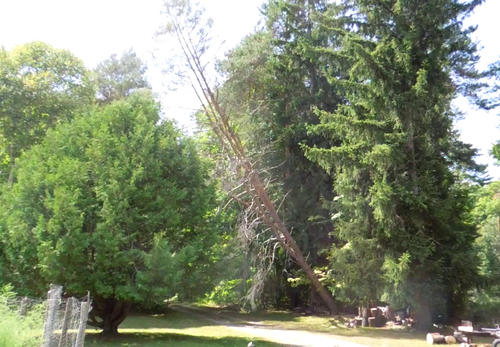 But I think I realized why it's done the way it is. If your notch went most
of the way across the tree, and the tree started falling the opposite
direction, there would be no way to stop it from falling over backwards.
With the shallow notch, the tree will pinch the chainsaw bar, but
will not fall over backwards. You then drive a thin aluminium wedge into the
kerf with a sledgehammer to open up the kerf.
Once you pound that wedge in far enough, the tree will
tilt in the direction you want it to fall, and eventually, it will come.
I don't have that much confidence or experience though, so I prefer to use
a winch to pull a tree back if it's leaning over a building.
But I think I realized why it's done the way it is. If your notch went most
of the way across the tree, and the tree started falling the opposite
direction, there would be no way to stop it from falling over backwards.
With the shallow notch, the tree will pinch the chainsaw bar, but
will not fall over backwards. You then drive a thin aluminium wedge into the
kerf with a sledgehammer to open up the kerf.
Once you pound that wedge in far enough, the tree will
tilt in the direction you want it to fall, and eventually, it will come.
I don't have that much confidence or experience though, so I prefer to use
a winch to pull a tree back if it's leaning over a building.
Typically, the tree will start to fall (or pinch the chainsaw) when there is about 5 cm or 2" of wood left. This remaining wood acts a bit like a hinge, and helps determine the direction of fall. I got it right with this one - it fell exactly where I wanted it, just barely missing trees on either side.
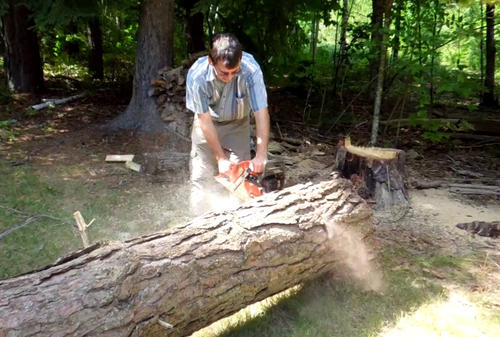 Several people have commented that the notch should always be angled down, not up
as like I'm cutting here. It's easier to cut angled up, but nobody has been able
to give a good reason for angling it down. I suspect that hen the tree falls and rips
apart the last fibres once that notch has closed, if the notch is level on top,
it pulls straight along the grain and is less likely to cause splits in the trunk
For firewood, that doesn't matter much. You can also get close to the ground
with an upward facing notch.
Several people have commented that the notch should always be angled down, not up
as like I'm cutting here. It's easier to cut angled up, but nobody has been able
to give a good reason for angling it down. I suspect that hen the tree falls and rips
apart the last fibres once that notch has closed, if the notch is level on top,
it pulls straight along the grain and is less likely to cause splits in the trunk
For firewood, that doesn't matter much. You can also get close to the ground
with an upward facing notch.
It's funny how many complicated machines for cross cutting logs can be seen in museums. I guess before chainsaws, that was the hardest part of making firewood.
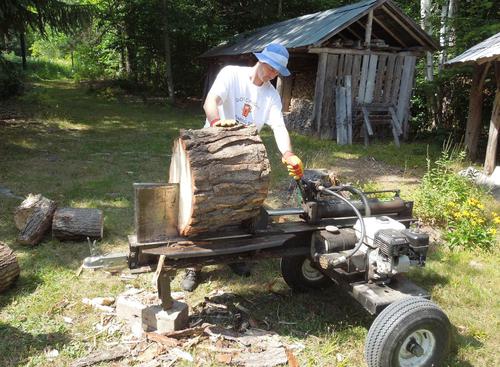 This tree yielded quite a few large chunks. A shame not to cut it into
boards, but for one log, it's not worth the trouble. and besides, my
homemade sawmill was far away,
and it isn't designed for coniferous trees (too sappy), nor for trees this large.
This tree yielded quite a few large chunks. A shame not to cut it into
boards, but for one log, it's not worth the trouble. and besides, my
homemade sawmill was far away,
and it isn't designed for coniferous trees (too sappy), nor for trees this large.
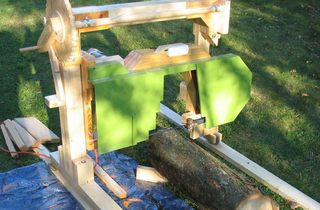 Backyard sawmilling
Backyard sawmilling Handplane sharpening
Handplane sharpeningfor barbarians
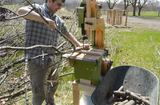 Making firewood with a bandsaw (video only)
Making firewood with a bandsaw (video only)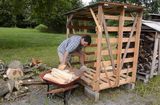 Movable firewood shed Move without restacking
Movable firewood shed Move without restacking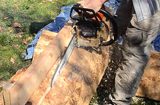 Chainsaw milling experiment
Chainsaw milling experiment DeWalt 60v chainsaw review
DeWalt 60v chainsaw review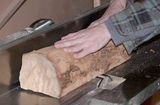 Cutting lumber from
Cutting lumber from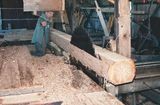 My dad's old sawmill
My dad's old sawmill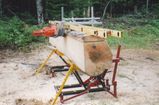 Chainsaw milling
Chainsaw milling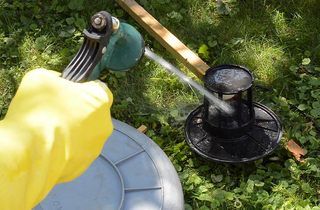 Flushing through a shopvac
Flushing through a shopvac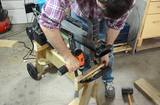 Electric log splitter stand
Electric log splitter stand